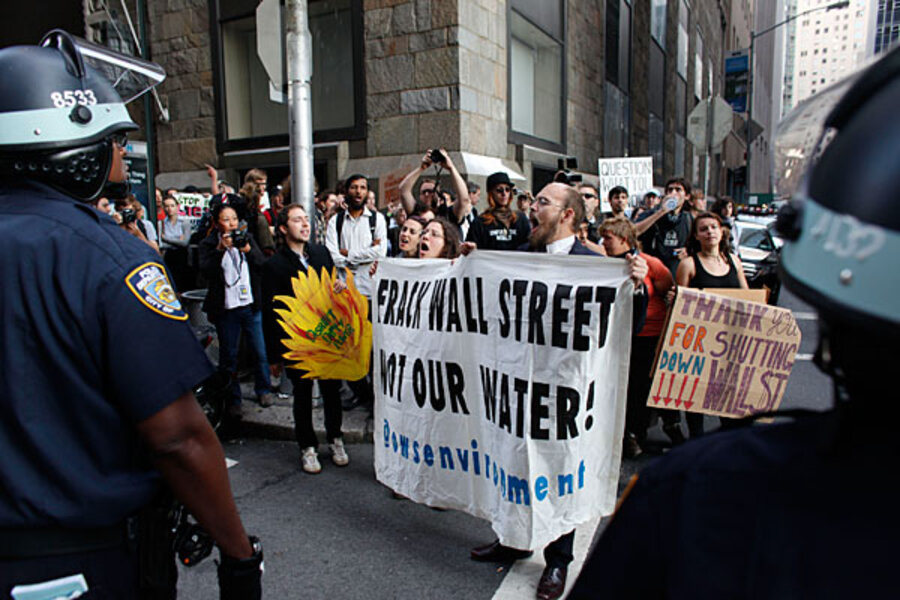Occupy Wall Street stages a comeback: What did it accomplish?
Loading...
| New York
On its one year anniversary, Occupy Wall Street spent a day marching around the Wall Street area, railing against the banks, and sometimes (through their civil disobedience) getting members arrested. There was plenty of street theater and no shortage of homemade signs, particularly about income inequality.
The overriding message: We are still here.
The execution was not always successful – an early-morning attempt to blockade Wall Street traders from getting to their jobs was foiled by New York Police Department. But Occupy's typical pastiche of protests – from ecology to education – were back in force.
“Today is more symbolic,” says John Zangas, an organizer from Washington, D.C., who was part of a group of 50 to 75 people who had come up to New York. “We are saying we have not given up.”
The effort was definitely needed, say observers of the Occupy movement. After New York City evicted the groups from its campground in Zuccotti Park last November, Occupy seemed to disappear. Despite an effort on May 1 to reinvigorate the group, not much happened through the summer.
“They lost some momentum,” says Heather Gautney, a sociologist at Fordham University and author of a book on the movement. “They are in a rebuilding stage.”
If they are rebuilding, they are doing it in their own unique way.
Some protesters donned outfits that looked they might belong in a Mardi Gras parade. Assemblies of individuals repeated short phrases from leaders in a kind of human megaphone. A “People’s Assembly” in Foley Park was planned.
On Monday, the organizers had divided lower Manhattan into different zones. In one area, protesters were concerned with debt, in another, ecology, in yet another, education, and around the Wall Street area was something termed 99 percent – referring to the concentration of wealth and influence into the top 1 percent.
“There has always been a resistance to one unifying theme that everyone agreed on,” says Alexis Goldstein, who works on a group called Foreclose the Banks. “There are so many issues people want to work on.”
Indeed, a Harrisburg, Pa., man who identified himself only as Lazlo said his main concern was fracking for oil and natural gas. He was referring to the drilling method that fractures geologic formations and is controversial because of pollution concerns.
Holding a cardboard sign about the wealth gap, Bob Nash of Cold Spring Harbor, N.Y., says the issue is that so few have so much. He fumes that the rich have “hijacked the country.”
The Rev. Michael Ellick, part of the Occupy Faith group, says his main concern is debt. “There is mortgage debt, medical debt, for a lot of us it’s student-loan debt, it is just crushingly disproportionate to what many of us make anymore.”
He says his group’s efforts are to get out stories about this debt for the next six to 12 months. “The idea is to frame these things into a broader context,” says Mr. Ellock of the Judson Memorial Church in New York. “Then, a lot of us are looking back at our ancient scriptures right now; we’re looking at Deuteronomy 15, where Moses says every seven years there should be total debt forgiveness for the poor.”
Yet experts on social movements say Occupy Wall Street needs to develop achievable goals and build alliances.
“Colorful protests are no substitute for door-to-door organizing,” says Stephen Zunes, a political scientist at the University of San Francisco.
Professor Zunes thinks Occupy will have to wait until after the election to get fully in gear. “Their natural ally, the trade unions, are distracted,” he says. “As disappointed as they are with Obama’s centrist economic policies, they are still trying to get him reelected.”
However, Ms. Gautney thinks Occupy has already had some influence on the election campaign. “Obama is saying the wealthy should pay their share,” she says. “Occupy has pushed for some time for a millionaire’s tax.”
One of the spokesmen for Occupy says that the group is maturing. “We are developing more specific goals,” says Jonathan Smucker, who works in the Occupy press area. “We are digging in.”
One example is Ms. Goldstein’s Foreclose the Banks group. She says its main goal is to draw attention to the fact that no major banker has been indicted for the financial meltdown that began in 2007.
Recently, when President Obama was in New York for a fundraiser, Foreclose the Banks held a fundraiser of its own to get money for the financial task force that was supposed to investigate the meltdown. The task force was “supposed to get $5 million, but that got cut down,” says Goldstein, explaining the need for the fundraiser. “There have been leaks to the press from the group saying they don’t have the resources to pursue the investigation.”





